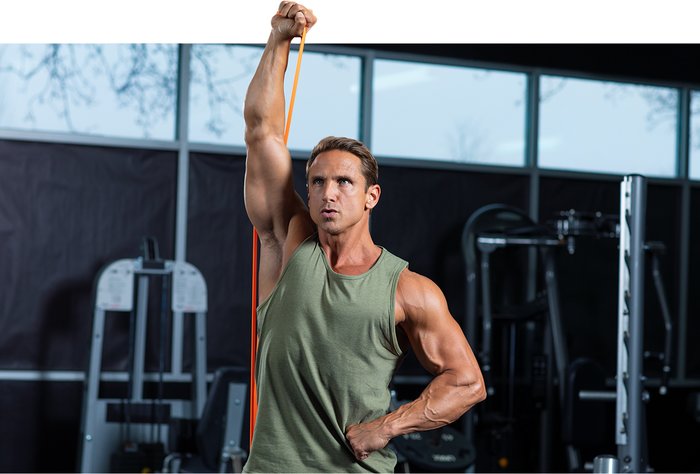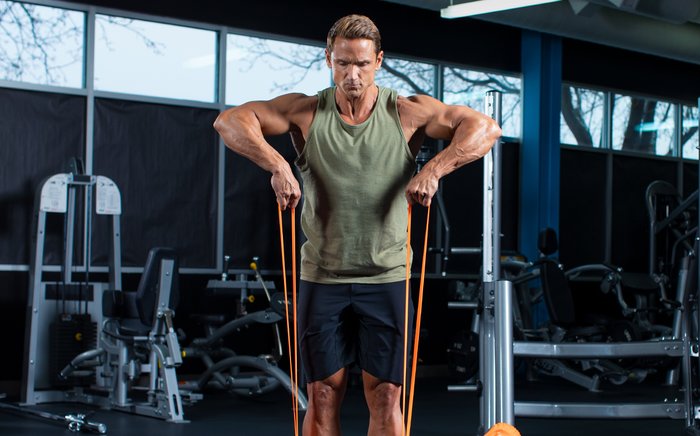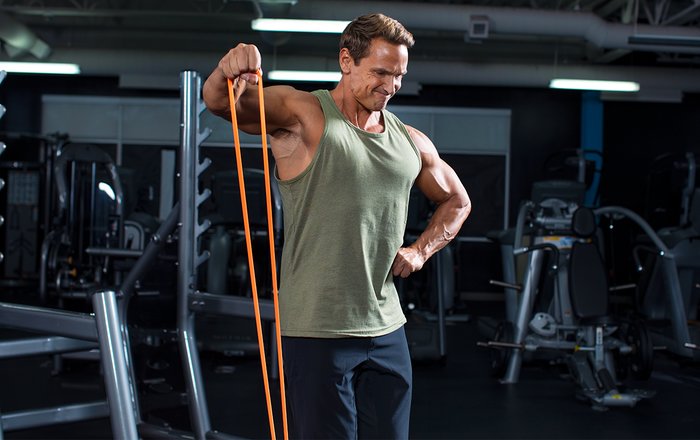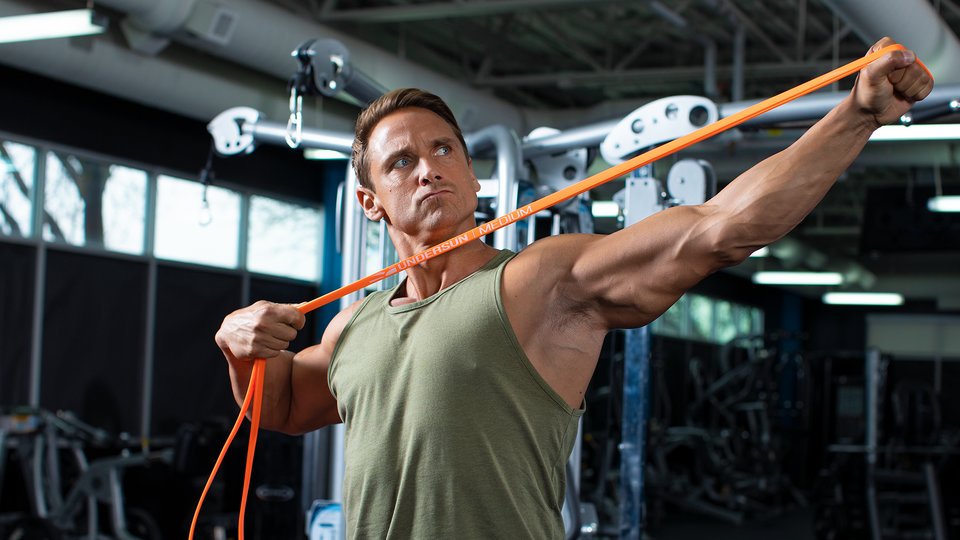Products You May Like
Using bands can provide a welcome relief from free weights, but that’s not all; bands can also provide exactly the stimulus your shoulders need to gain size and strength. To test this theory, we brought together two completely different training styles to create one intense shoulder workout. Worlds collide as fitness model David Morin and Bodybuilding.com employee and Strongwoman competitor Rachel Pyron band together for this challenging session. Morin has been using bands in his training for some time and is eager to show what they can do.
“After weight training for many, many years, I’ve experienced weaknesses in joints,” he says. “These areas of opportunity are where I can use a different modality to create strength in those joints.”
Pyron, on the other hand, admits that, like many in her sport, she uses bands primarily for warm-ups.
“I think that’s kind of traditionally how they are used in the Strongman world,” she explains. “Especially when you’re traveling and you don’t have a lot of equipment to warm up with.”
Morin and Pyron take you through a succession of movements to challenge your shoulders and target the secondary muscles around the shoulder joint. If you’ve only used dumbbells and cables, this workout will feel very different. That’s normal, according to Morin.
“You’re going to get that metabolic stimulation in the muscle tissue and a lot of blood flow,” he says. “Which is all going to be great for the shoulder health in general.”
Band Shoulder Workout
- Single-arm band shoulder press: 3 sets of 20 reps per side
- Band upright row: 3 sets of 15-20 reps
- Band raise-fly-row combo: 3 sets of 10 reps
- Single-arm band lateral raise: 3 sets of max reps per side
Technique Tips
Single-Arm Band Shoulder Press
“The differentiation with this type of band resistance versus your typical standard dumbbell or barbell presses is that it’s a unilateral exercise that challenges your stability on the opposing side,” Morin says. “The way that your body has to move and engage to get the full range of motion is going to stimulate the shoulder through a greater range.”

Stand on the band with one foot, pull the band up on that side as you would for a biceps curl, rotate your arm palm forward, and press. To modify the movement and add a bit more challenge, Morin suggests rotating as you’re pressing up to mimic the movement of an Arnold press and get both front- and side-delt activation.
To add more resistance, simply wrap the band around the opposite foot and step on it with the original foot. This shortens the band and enables you to change the resistance simply by adjusting your stance: The wider you step, the more resistance you create; the narrower you stand, the less resistance. You can even change the resistance in the middle of a set to get a few extra reps.
“Toward the end of my set, if I want to do a dropset and dial back the resistance, I bring my feet closer together,” Morin says.
Once you reach 20 reps on the first side, switch the setup and complete 20 reps on the other side.
Upright Row
Switch bands if you need to on this exercise and remember that you can always increase the resistance by taking a wider stance. Stand on the band and hold the other side with your hands about shoulder-width apart in the start position. You’re aiming for fewer reps than you did on the shoulder press, just enough to get that medial-delt activation.
If you’ve struggled with joint issues on upright rows, switching to bands can be very helpful.

“I don’t ever do these with barbells because it hurts,” Pyron admits. “But using bands is nice. It’s a lot less strain.”
For the upright row, you want to connect to the muscle that you’re training and not let other muscles take over. This is about the medial delts, not the traps. The higher you pull, the more the traps are going to get involved, so only pull up to about chest level. Keep your knees soft to take the pressure off your lower back, and if you need help activating the muscle you’re trying to isolate, Morin recommends you close your eyes and really connect to that muscle.
Band Raise-Fly-Row Combo
This combination exercise is unique to band training, but all the components should feel familiar. Stand on one end of the band with both feet as you pull the other end up in a front raise.
Keeping your arms at approximately shoulder height, pull the band apart in a rear delt fly, engaging the rear delts with the pull and the medial delts by holding the band high. Bring the band back to center, then bend your elbows back to pull the band to your chest. Extend your elbows to push the band back out and reactivate the front delts, then lower to the starting position. This entire sequence counts as one rep. Keep your knees soft to take the pressure off your back, and if you need more resistance, take a wider stance.
Morin is quick to point out that using the right band for each exercise matters more than ego.
“You can always scale it back if it’s too hard by grabbing a lighter band,” he says. “There’s no ego here—you just want growth and progress.”
Single-Arm Band Lateral Raise
No shoulder workout would be complete without the lateral raise, and the goal here is burnout, aka, as many reps as possible.
“Some days you have more reps in you than others,” explains Morin. “With bands, you can safely go past thresholds without injuring yourself and impairing the joints.”
To push yourself on burnout, you can do one of two things: Increase the resistance by widening your stance, or do extra reps.

As with the shoulder press, Morin prefers to do these one arm at a time because it forces you to engage your core. Loop the band over the opposite foot and stand on it with the same foot as the working arm. Pull the band up and to the side to just over parallel, about ear height.
“I like how there’s tension the whole time,” says Pyron. “A lot of time if I try to use a cable, even the lightest setting is really too heavy to do a burnout set on a shoulder raise without cheating it. I think the bands are a lot more appropriate for when you’re wanting to use lighter weight.”
When you lift with bands, there’s always tension, especially at the top of the movement where the band is stretched the farthest. As Morin points out, using bands is every bit as effective as using free weights.
“It’s a much better feeling for me when I use bands and I get that top resistance,” he says. “Then if I go back and use dumbbells again, it’s a whole different world.”
As you can see from this workout, using bands to train shoulders is a challenge. If you focus on controlled reps and trying not to cheat your way through, you’ll find the bands are very effective for building muscle and strength without as much risk for joint pain or injury.
For a full-body resistance band workout, check out the 20-minute Undersun Band HIIT workout, and be sure to pick up your own set of Undersun bands by visiting the Bodybuilding.com store today!
